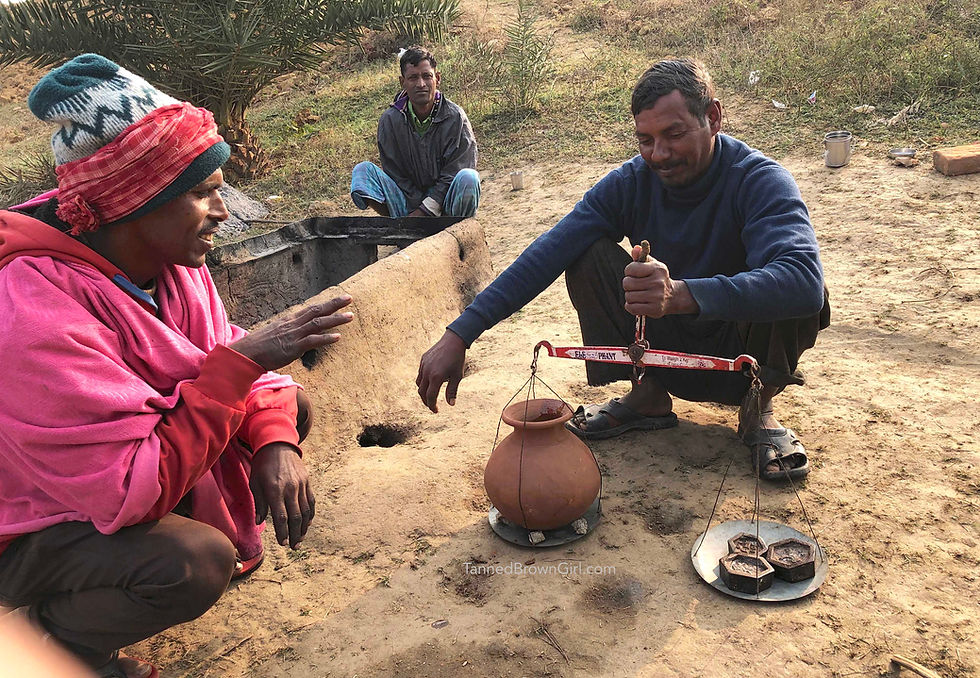The making of Nolen Gur or Date Palm Jaggery, a winter treat of Bengal
- Kunj Shah
- Jan 13, 2020
- 3 min read
Updated: Jan 28, 2020
The slightly sticky and smokey jaggery, Nolen Gur, makes its way into Bengali sweets in winters, but goes through an elaborate extraction process to get there.

Between December and February, in the brief winter spell in West Bengal, the distinguished mishti-lovers of our country, go into a dessert hysteria. The seasonal treat Nolen Gur makes its appearance in Bengali sweets, making them even more sought after.
Nolen Gur translates to new jaggery in Bengali. New for me, because I've not seen jaggery retailed in liquid form. For 4 cold months, every halwai uses it as a key ingredient in the usual sweets like Rasagulla, Sandesh and Payesh.
Nolen Gur comes from date palm trees and is extracted only during the winter months using deft skills. I would have never known that though, if I hadn't decided to go out and pluck fresh vegetables from a farm in Raipur, about 20 km away from Shantiniketan.
I stumbled upon this process on a cold December dawn, a pillion on a scooter, swaddled in layers of woollen. Every inch of my face was multi-wrapped in a shawl but for my eyes. They were too busy consuming the green landscape, a mosaic of cabbage, spinach, paddy and Brinjal farms. The green was interrupted by plumes of smoke in a sudden dry patch. A closer look revealed a large, rectangular tray on high flame, and a brown liquid boiling in it. Half a dozen villagers were busy around it.
"They are making Nolen Gur," said my friend excitedly and brought the scooter to a halt. The date palm sap was bubbling and sloshing from side to side in the tray. A man by the earthen stove was fuelling the fire every few minutes with dried palm leaves. A worker was washing earthen vats and another was laying them upside down to dry. The thick smoke cleared a little to reveal a man by the tray, stirring the liquid with a palm stem as a spatula. He looked like a genie brewing magic.
"In about an hour the liquid jaggery will be ready to be filled in the earthen vats", he said, as he explained THE EXTRACTION PROCESS -
With the onset of winter, thoroughly cleaned pots are fitted to date palm trees wherein the sap gets collected by a tapper. It is left in the containers all night.

The liquid is then boiled and thickened, usually in a metal container, on high flame, with constant stirring for 2-3 hours. The flame is fuelled by dried palm leaves.

It is then manually cooled in the winter morning air, by which time it turns into an amber-gold sticky liquid, not too thin, not too thick.

It is then stored in earthen vats to retain the goodness through the next few months of the fleeting winter, and for easy trade.

Traders wait on the making grounds and buy the stock fresh. Most of the stock is sold within the day and taken into the cities and towns for mass distribution.

The fresh-off-the-stove jaggery is poured into my palm. It has a deep sweetness that’s not sugary, and lingers with a smokey aftertaste. As I lick my palm, my tongue comprehends the hysteria that consumes the Bengalis in the winter months.
Nolen Gur also makes its way into moyas, rasogollas, sandesh, jalbhora, kanchagolla, the classic sweets. Nolen Gur soufflés and crème bruleés are the more contemporary avatars. My pick of the spread is Nolen Gur ice cream!
For those who are tutting over too much of an indulgence, shed your guilt at once. The gur is not only delicious but also packed with vitamins and minerals that aid digestion and weight loss. It is iron-rich and has micronutrients that provide immunity to the body from infections during the season. Celebrity nutritionist Rujuta Diwekar says it is ”a feast for sore eyes, rusty gut and cramped calf muscles.”

The chance experience of the making process was a surprise treat. But the real treat was waiting for me at lunch at my place of stay. My friend had made a delicious traditional Payesh from the morning stash of Nolen Gur.
It immediately turned a non-sweet tooth like me into a mishit-lover. But only for the short winter season.
If you can lay your hands on Nolen Gur, which will be available till mid-March, here's a traditional RECIPE for you specially from Bengal -
Nolen Gurer Sandesh
Ingredients
500 gm cottage cheese (chhena), 2 tbsp refined sugar, 4-5 tbsp Nolen Gur (date palm jaggery), 1 tsp ghee, raisins, moulds
Method
On a flat plate, mash chhena for 8 to10 minutes. Add refined sugar and Nolen Gur. Mix thoroughly. Heat a non-stick pan (kadai) on low flame and cook the mixture for 5 to 7 minutes. Keep stirring. Pour the mixture on a flat plate. Make 10 round balls of equal size. Take a mould, grease it with ghee and press it to each ball to give it a nice shape. Garnish each sandesh with raisin. Refrigerate for 30 minutes before serving.






Comments